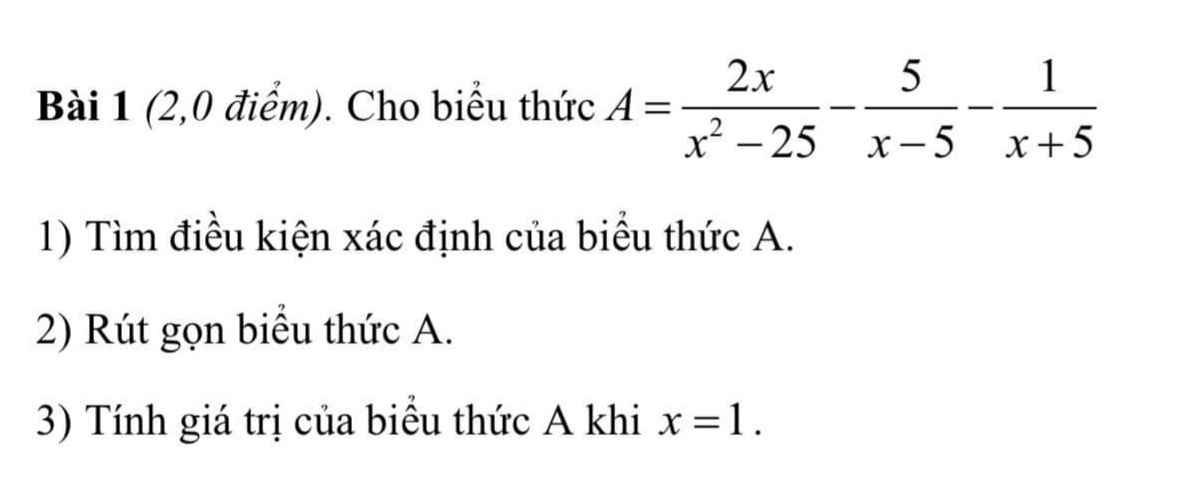
Hãy nhập câu hỏi của bạn vào đây, nếu là tài khoản VIP, bạn sẽ được ưu tiên trả lời.


Ta có: \(\left(x+\frac{1}{x}\right)^3=x^3+\frac{1}{x^3}+3.1.\frac{1}{x}.\left(1+\frac{1}{x}\right)\)\(=a^3\)
\(< =>x^3+\frac{1}{x^3}+3.\left(1+\frac{1}{x}\right)=a^3\)
\(< =>x^3+\frac{1}{x^3}=a^3-3a\)
Lại có: \(\left(x+\frac{1}{x}\right)^5=x^5+\frac{1}{x^5}+5.\left(x^3+\frac{1}{x^3}\right)+10.\left(x+\frac{1}{x}\right)=a^5\)
\(< =>x^5+\frac{1}{x^5}+5.\left(a^3-3a\right)+10.a=a^5\)
\(< =>x^5+\frac{1}{x^5}+5a^3-15a+10a=a^5\)
\(< =>x^5+\frac{1}{x^5}=a^5-5a^3+5a\)

đkxđ:\(x\ne5,x\ne-5\)
\(\dfrac{2x}{\left(x-5\right)\left(x+5\right)}-\dfrac{5}{x-5}-\dfrac{1}{x+5}\)
\(\dfrac{2x}{\left(x-5\right)\left(x+5\right)}-\dfrac{5x+25}{\left(x-5\right)\left(x+5\right)}-\dfrac{x-5}{\left(x-5\right)\left(x+5\right)}\)
\(\dfrac{2x-5x-25-x+5}{\left(x-5\right)\left(x+5\right)}=\dfrac{-4x-20}{\left(x-5\right)\left(x+5\right)}=\dfrac{-4\left(x+5\right)}{\left(x-5\right)\left(x+5\right)}=-\dfrac{4}{x-5}\)
thay x=1 vào bt A, ta được:
\(-\dfrac{4}{1-5}=1\)

Bài 4 :
Thay x=y+5 , ta có :
a ) ( y+5)*(y5+2)+y*(y-2)-2y*(y+5)+65
=(y+5)*(y+7)+y^2-2y-2y^2-10y+65
=y^2+7y+5y+35-y^2-2y-2y^2-10y+65
= 100
Bài 5 :
A = 15x-23y
B = 2x-3y
Ta có : A-B
= ( 15x -23y)-(2x-3y)
=15x-23y-2x-3y
=13x-26y
=13x*(x-2y) chia hết cho 13
=> Nếu A chia hết cho 13 thì B chia hết cho 13 và ngược lại

a) \(A=\dfrac{x^2+3x}{x^2-25}+\dfrac{1}{x+5};B=\dfrac{x-5}{x+2}\left(x\ne\pm5;-2\right)\)
Khi \(x=9\) thì :
\(B=\dfrac{9-5}{9+2}=\dfrac{4}{11}\)
b) \(P=A.B\)
\(\Leftrightarrow P=\left[\dfrac{x^2+3x}{x^2-25}+\dfrac{1}{x+5}\right].\dfrac{x-5}{x+2}\)
\(\Leftrightarrow P=\left[\dfrac{x^2+3x}{\left(x+5\right)\left(x-5\right)}+\dfrac{x-5}{\left(x+5\right)\left(x-5\right)}\right].\dfrac{x-5}{x+2}\)
\(\Leftrightarrow P=\left[\dfrac{x^2+4x-5}{\left(x+5\right)\left(x-5\right)}\right].\dfrac{x-5}{x+2}\)
\(\Leftrightarrow P=\left[\dfrac{x^2+5x-x-5}{x+5}\right].\dfrac{1}{x+2}\)
\(\Leftrightarrow P=\left[\dfrac{x\left(x+5\right)-\left(x+5\right)}{x+5}\right].\dfrac{1}{x+2}\)
\(\Leftrightarrow P=\left[\dfrac{\left(x+5\right)\left(x-1\right)}{x+5}\right].\dfrac{1}{x+2}\)
\(\Leftrightarrow P=\dfrac{x-1}{x+2}\)
c) Theo đề bài để
\(P=\dfrac{x-1}{x+2}>\dfrac{1}{3}\left(x>-2\right)\)
\(\Leftrightarrow3\left(x-1\right)>x+2\)
\(\Leftrightarrow3x-3>x+2\)
\(\Leftrightarrow2x>5\)
\(\Leftrightarrow x>\dfrac{5}{2}\left(thỏa,đk:x>-2\right)\)
a) Để tính giá trị của B khi x = 9, ta thay x = 9 vào biểu thức B: B = (x - 5)/(x + 2) - 5/(x + 2) = (9 - 5)/(9 + 2) - 5/(9 + 2) = 4/11 - 5/11 = -1/11
Vậy giá trị của B khi x = 9 là -1/11.
b) Để rút gọn biểu thức P = A.B, ta nhân các thành phần tương ứng của A và B: P = (x^2 + 3x)/(x^2 - 25 + 1) * (x - 5)/(x + 2) = (x(x + 3))/(x^2 - 24) * (x - 5)/(x + 2) = (x(x + 3)(x - 5))/(x^2 - 24)(x + 2)
Vậy biểu thức P được rút gọn thành P = (x(x + 3)(x - 5))/(x^2 - 24)(x + 2).
c) Để tìm giá trị của x khi P > 13 với x > -2, ta giải phương trình: (x(x + 3)(x - 5))/(x^2 - 24)(x + 2) > 13

a) \(A=\left(x-y\right).\left(x^2+x+y\right)-x.\left(2x^2+2y^3\right)\)
\(=x^3+x^2+xy-x^2y-xy-y^2-2x^3-2xy^3\)
\(=-x^3-y^2-2xy^3\)
b) Ta thay \(x=-1;y=-5\)
\(-x^3-y^2-2xy^3\)
\(=-\left(-1\right)^3-\left(-5\right)^2-2.\left(-1\right).\left(-5\right)^3\)
\(=1-25-250\)
\(=-274\)

Bài 1 :
a) \(ĐKXĐ:x\ne1\)
\(A=\left(\frac{3}{x^2-1}+\frac{1}{x+1}\right):\frac{1}{x+1}\)
\(\Leftrightarrow A=\frac{3+x-1}{\left(x-1\right)\left(x+1\right)}\cdot\left(x+1\right)\)
\(\Leftrightarrow A=\frac{x+2}{x-1}\)
b) Thay x = \(\frac{2}{5}\)vào A ta được :
\(A=\frac{\frac{2}{5}+2}{\frac{2}{5}-1}=\frac{\frac{12}{5}}{-\frac{3}{5}}=-4\)
c) Để \(A=\frac{5}{4}\)
\(\Leftrightarrow\frac{x+2}{x-1}=\frac{5}{4}\)
\(\Leftrightarrow4x+8=5x-5\)
\(\Leftrightarrow x=13\)
d) Để \(A>\frac{1}{2}\)
\(\Leftrightarrow\frac{x+2}{x-1}>\frac{1}{2}\)
\(\Leftrightarrow\frac{x+2}{x-1}-\frac{1}{2}>0\)
\(\Leftrightarrow2x+4-x+1>0\)
\(\Leftrightarrow x+5>0\)
\(\Leftrightarrow x>-5\)
Bài 2 :
a) \(ĐKXĐ:\hept{\begin{cases}x\ne-1\\x\ne0\end{cases}}\)
\(A=\frac{x^2}{x^2+x}-\frac{1-x}{x+1}\)
\(A=\frac{x}{x+1}+\frac{x-1}{x+1}\)
\(\Leftrightarrow A=\frac{2x-1}{x+1}\)
b) Để \(A=1\)
\(\Leftrightarrow\frac{2x-1}{x+1}=1\)
\(\Leftrightarrow2x-1=x+1\)
\(\Leftrightarrow x=2\)
b) Để \(A< 2\)
\(\Leftrightarrow\frac{2x-1}{x+1}< 2\)
\(\Leftrightarrow\frac{2x-1}{x+1}-2< 0\)
\(\Leftrightarrow2x-1-2x-1< 0\)
\(\Leftrightarrow-2< 0\)(luôn đúng)
Vậy A < 2 <=> mọi x

a) A = (x - 5)(x² + 5x + 25) - (x - 2)(x + 2) + x(x² + x + 4)
= x³ - 125 - x² + 4 + x³ + x² + 4x
= (x³ + x³) + (-x² + x²) + 4x + (-125 + 4)
= 2x³ + 4x - 121
b) Tại x = -2 ta có:
A = 2.(-2)³ + 4.(-2) - 121
= 2.(-8) - 8 - 121
= -16 - 129
= -145
c) x² - 1 = 0
x² = 1
x = -1; x = 1
*) Tại x = -1 ta có:
A = 2.(-1)³ + 4.(-1) - 121
= 2.(-1) - 4 - 121
= -2 - 125
= -127
*) Tại x = 1 ta có:
A = 2.1³ + 4.1 - 121
= 2.1 + 4 - 121
= 2 - 117
= -115
